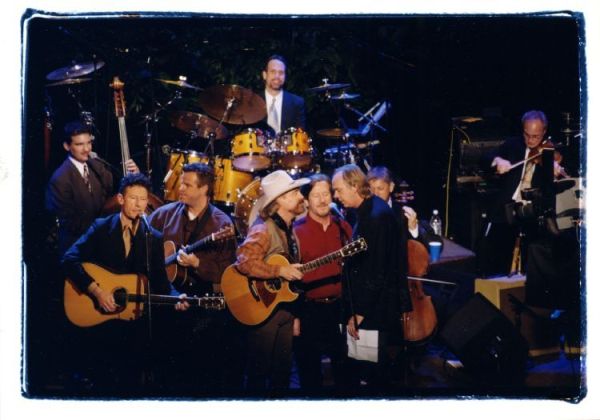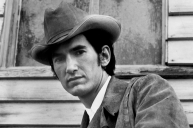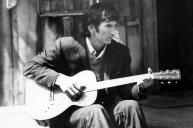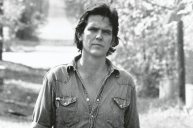[dropcap]T[/dropcap]wenty years ago this September, Lyle Lovett released Step Inside This House, an intimate, yet sprawling double-album of covers by Texas singer-songwriters. Up until that time, the vast majority of Lovett's work consisted of songs he'd written and composed himself. With Step Inside This House, the house may as well be a time machine of sorts.
Videos by Wide Open Country
What may have spurred on Lovett's love letter to Texas songwriting was a plethora of things. Four years prior, he had released I Love Everybody, an 18 song collection that took us back to a pre-'86 (the year of his debut album) Lovett version. In '93, fellow Houston singer-songwriter Nanci Griffith released Other Voices, Other Rooms, which too was a collection of covers that spoke to Griffith and ultimately inspired her as a young artist. Townes Van Zandt's '93 Roadsongs was very much the same. Lovett would take the concept a step further on Step Inside This House by focusing solely on the voices of Texas songwriters.
Essentially, there are two incredibly critical aspects of Lovett's Step Inside This House. For starters, Lovett sheds a light on some of the most gifted, but criminally underrated singer-songwriters of the past 50 years. It's a step back in time where Lovett is essentially curating what Houston and Austin were like in the '70s and early '80s. Touchstone artists like Van Zandt, Guy Clark, Willis Alan Ramsey, Michael Martin Murphey and Robert Earl Keen are the standards of the time and style, but Lovett digs further than just showcasing these relatively known figures. Songs by the likes of Steven Fromholz, Walter Hyatt, Eric Taylor, Vince Bell and David Rodriguez are all part of the equation. For this, Step Inside This House is more than just a great selection of covers. It's a guideline and proper introduction to Texas music.
If Clark, Hyatt, Van Zandt and company are the who, the other key aspect is understanding why. While he didn't write a single line on Step Inside This House, it very well could be his most personal album up until that point. Over the course of 21 songs, Lovett slowly begins to peel back the layers of an artist. You simultaneously see two versions of Lyle Lovett--the early beginner and the veteran storyteller.
There's a reason why these songs resonated with Lovett at an early age and why they remained as central forces in his songwriting in 1998 and into the present day. Many times, you fall out of love with songs or simply forget them. You forget why they spoke to a younger version of yourself. They fade with memory and time. Others, they endure because the simple truths and raw emotions they exhibit and emphasize are still as relevant as the day you heard them.
Going back to the origins of these songs and the writers who created them, you get an added perspective and understanding of Lovett's own music. Jazz, country, r&b, traditional folk, blues--these are large pieces of his musical roots. Like with the vast majority of his career, Step Inside This House is a blending of these sounds and styles. It's more than just that though. Lovett's narratives, wry vignettes, tearjerkers, cadence and croon call all be traced back to these original influences. He may not have written these songs, but Lovett and company speak the same language.
Even while there are all these unique and specific movements and forces at work, Step Inside This House is remarkably unified in sound. Much of this can be attributed to its soft edges and focus on lush, but typically reserved renditions. Musicians such as Sam Bush, Jerry Douglas, Stuart Duncan, Paul Franklin, John Hagen and Matt Rollings are an integral part of shaping the album. And as the title suggests, this is Lovett opening the door and inviting you in. It's just as much an album made for the living room as it is the small and intimate rooms of the Austin and Houston music scenes.
Simply put, Lovett weaves the stylings of these different songwriters with perfection. He captures the spirit of each song without ever losing his own. He sings them as if they were his own. His vocals aren't always perfect. There's some give. His voice cracks ever so slightly here and there. It's genuine and real.
Now, some 20 years later, Lovett's Step Inside This House--an album primarily of songs that influenced Lovett some 20 years before that--still holds a relevancy and weight to it. Lovett continues to push the boundaries and challenges the status quo interpretation of what country music is and can be. Ultimately, that's one of Step Inside This House's defining statements.
Step Inside This House is timeless. It's a graceful interpretation of the Texas songwriter and storyteller. It's a genuine acknowledgment and a glimpse into what makes Lovett tick as a storyteller himself.
Disc One
1. "Bears"
- "Bears" was written by Steven Fromholz and appeared on his '76 album A Rumor In My Own Time. Fromholz is one of the ultimate cult figure icons in Texas music. As criminally underrated and obscure as artists like Townes Van Zandt and Willis Alan Ramsey are, Fromholz (and Eric Taylor, Walter Hyatt, etc) are that much more.
- The setup of Step Inside This House is very intentional. While there are similarities and themes that run throughout, the two parts of the album (Disc One and Two) are very distinct sets. Disc One finds Lovett examining 11 songs by 11 different artists (one being a traditional).
2. "Lungs"
- "Lungs" was originally written by Townes Van Zandt and first appeared on his '69 self-titled album. There's gritty texture added by Lovett and company that raise the intensity on the old-school miner's lament. Disc One finds Lovett going in various directions. He follows up the ever humorous and fun "Bears" with an incredibly dark and somber cry in "Lungs."
3. "Step Inside This House"
- "Step Inside This House," originally written by Guy Clark, was the first song he ever wrote down and one he never recorded. Lovett was introduced to the song by songwriter Eric Taylor (who wrote "Memphis Midnight/Memphis Morning"). At this point, it had become a "shared" song of sorts by local Houston songwriters. By this time, it had morphed from being "Step Inside My House" to "Step Inside This House." Clark, Lovett, Joe Ely and John Hiatt would do a handful of acoustic shows together in mid-to-late '90s. One night, Lovett surprised Clark by playing it, saying it was a song he wishes he had written. That night, Clark told them it was the first song he had ever written.
- Clark was first introduced to Lovett's music in the mid-'80s after receiving one of Lovett's demo tapes. The impressed Clark was making copies and passing it around to various people in Nashville, eventually passing a copy to Tony Brown at MCA Records, which signed Lovett to a record deal in the late '80s.
- "Step Inside This House" is essential to Lovett's Step Inside This House as a whole. There's a reason he named the album after the song. The painting, book of poems, piece of glass, guitar--all the items listed--they may as well be the other 20 songs on the album.
4. "Memphis Midnight/Memphis Morning"
- "Memphis Midnight/Memphis Morning" was written by Eric Taylor. Taylor, a long-time Houston-based singer-songwriter was one of Lovett's first mentors. At one point, Houston's music scene was thriving with songwriters like Clark, Van Zandt and others dominating the scene with memorable performances at venues like Anderson Fair. Along with the likes of Vince Bell, Taylor stayed in Houston after Clark and Van Zandt had moved up to Nashville. As Lovett says it, "He and a few other people like Vince Bell were the keepers of that flame in terms of Townes' and Guy's songwriting ethic. I learned so much from the way he structured a song, what to put in, what to leave out. I'd try to learn his songs within days of hearing them."
- Taylor and Lovett's relationship runs deep. Lovett has recorded Taylor's "Whooping Crane" on Natural Forces and "Understand You" on Release Me. The Taylor and Lovett co-write "Fat Babies" appears on I Love Everybody. Lovett also provided harmony vocals on Taylor's '95 album, Eric Taylor. In addition, Lovett appears on the Live at Red Shack album in which the two sing "Memphis Midnight/Memphis Morning."
5. "I've Had Enough"
- "I've Had Enough" is by Vince Bell and Craig Calvert and first appeared on Bell's '95 album, Phoenix, which also featured harmony vocals contributed by Lovett. Lovett would also go on to cover Bell's "Sun and Moon and Stars" for the album Natural Forces.
- Like Taylor, Bell was part of the Houston music scene that had a large impact on Lovett when he was first coming into his own as a songwriter. Lovett would watch Bell, Taylor and others perform at Anderson Fair, The Old Quarter and other Houston area venues.
6. "Teach Me About Love"
- "Teach Me About Love" was written by Walter Hyatt. Along with David Ball and Champ Hood, Hyatt formed Uncle Walt's Band. Though the band never reached more than a cult following, they would prove to be highly influential on Lovett's sound and songs. Lovett uses three other Hyatt songs on Step Inside This House, "Babes in the Woods," "Lonely in Love" and "I'll Come Knockin'." With Billy Williams, Lovett would produce Hyatt's 1990 album King Tears. "Teach Me About Love" first appeared on Hyatt's 1993 album, Music Town.
- Lovett would reunite the trio behind Uncle Walt's Band on 1989's Lyle Lovett and His Large Band on the song "Once Is Enough." Lovett would also reference the trio on "That's Right (You're Not From Texas)" on a handful of verses ("Those boys from Carolina. They, sure enough, could sing...").
7. "Sleepwalking"
- "Sleepwalking" was written by Willis Alan Ramsey but has yet to be recorded by Ramsey. A noted perfectionist, Ramsey has only released a single album, his legendary 1972 self-titled debut (though, he did announce his plans to release new material earlier this year). Over the years, a handful of Ramsey songs have made their way out, one of them being "Sleepwalking." Lovett and Ramsey also collaborated on two Lovett songs, Joshua Judges Ruth's "North Dakota" and The Road to Ensenada's "That's Right (You're Not From Texas)," which was written with Alison Rogers.
- In a Texas Monthly feature, Lovett said "Willis taught me so much. Listening to his record showed me that you don't have to play straight-ahead blues to have blues be a part of your music. He's so soulful."
8. "Ballad of the Snow Leopard and the Tanqueray Cowboy"
- "Ballad of the Snow Leopard and the Tanqueray Cowboy" was written by David Rodriguez. It first appeared on a Rodriguez live album called Man Against Beast, which was released on cassette in '90. Rodriguez was a Houston born and raised singer-songwriter who began getting a following in the early '90s. He eventually became a lawyer and ran for office in Texas before moving to Holland. His daughter is songwriter and fiddle player Carrie Rodriguez. They appear together on the '07 live album A Winter Moon, which includes "Ballad of the Snow Leopard and the Tanqueray Cowboy."
- It's one of the most complex songs on the album and takes multiple listens to begin to grasp the deep beauty within the slow-pacing ballad. Thankfully, Lovett lends his focus directly upon the lyrics and scales back for the serene piece. By any measure, "Ballad of the Snow Leopard and the Tanqueray Cowboy" is the most poetic song on Step Inside This House.
9. "More Pretty Girls Than One"
- "More Pretty Girls Than One" is a traditional song and marks as the first of two featured on Step Inside This House. It's a long-time bluegrass number having been covered by the likes of Woody Guthrie, Doc Watson, Ramblin' Jack Elliott and Ricky Skaggs.
- The first version of "More Pretty Girls Than One" was recorded in 1936 by Fiddlin' Arthur Smith as "There's More Pretty Girls Than One."
10. "West Texas Highway"
- "West Texas Highway" was written by Michael Martin Murphey and Boomer Castleman. Though written in the '70s, "West Texas Highway" wouldn't appear on a Murphey album until being recorded for the 2012 live album Campfire on the Road. The first time "West Texas Highway" was actually recorded though was in 1971 by the short-lived band Three Faces West, which included Ray Wylie Hubbard and Rick Fowler. Lovett first heard the song in 1975 at a Murphy concert.
11. "Rollin' By"
- "Rollin' By" was written by Robert Earl Keen, one of Lovett's long-time collaborators. Keen recorded the song in 1984 on his debut album, No Kinda Dancer. The two first met one another while both attended Texas A&M University. Their first prominent collaboration was "The Front Porch Song," which appeared on No Kinda Dancer and Lovett's 1986 debut, Lyle Lovett. The two would also write "It's Rock and Roll," which appeared on Lovett's Natural Forces.
- Though Lovett would become friends with the majority of songwriters featured on Step Inside This House, Keen is the lone artist who is truly one of Lovett's contemporaries. Lovett says he remembers the day Keen first played "Rollin' By," stating that he made Keen play it enough times so he could learn it himself.

Lyle Lovett, Robert Earl Keen, Michael Martin Murphy, Vince Bell, and Eric Taylor performing on Step Inside This House: Austin City Limits. David Roth.
Read More: 15 Songs That Embody the Texan Spirit
Disc Two
1. "Texas Trilogy: Daybreak"
2. "Texas Trilogy: Train Ride"
3. "Texas Trilogy: Bosque County Romance"
- Though broken down into three songs, "Texas Trilogy" has always been meant to be listened to as a single composition. Written by Fromholz, they first appeared on the 1969 album From Here to There. The long-out-of-print album was recorded by Frummox, a duo consisting of Fromholz and Dan McCrimmon.
- The three-part "Texas Trilogy" is set in the small town of Kopperl, Texas. Fromholz' maternal grandmother, Hirstine Hughes, was from the small town. Fromholz lived in Kopperl for extended periods of his youth. These memories would heavily influence Fromholz' writing, none more so than on the "Texas Trilogy." Specifically, the songs would inspire two books: 2002's Texas Trilogy: Life in a Small Texas Town by Craig D. Hillis and Bruce F. Jordan and 2007's A Texas Trilogy by Fromholz himself.
- The rural life found in "Texas Trilogy" reminded Lovett of his own upbringing in Klein, Texas, outside of Houston. While certainly character driven, "Texas Trilogy" really works because of its' rural small Texas town setting. Fromholz breathes life into Kopperl that feels uniquely specific, but undoubtedly universal. As Hillis says in Texas Trilogy: Life in a Small Texas Town, "the big deal about Kopperl, Texas, was that it wasn't any kind of big deal at all."
4. "Flyin' Shoes"
- "Flyin' Shoes" was written by Van Zandt and recorded on the 1978 album, Flyin' Shoes. The song was written by Van Zandt while sitting by the Harpeth River and thinking about the Civil War battle, Battle of Franklin, which took place near the Harpeth. Van Zandt's "Flyin' Shoes" sees him morph into a mortally wounded soldier wishing to leave the battle and this mortal coil behind.
- Lovett first learned "Flyin' Shoes" at eighteen-years-old. In the book I'll Be Here in the Morning: The Songwriting Legacy of Townes Van Zandt, Lovett says, "I loved the chord changes, the lyrical idea of leaving everything you know and love behind and embarking on an unknown course. That notion's a very real thing when you're eighteen."
5. "Babes in the Woods"
- Hyatt was one of Lovett's closest friends. He tragically passed away in 1996 in a ValueJet plane crash in the Florida Everglades two years before Step Inside This House was recorded. Van Zandt would die on New Year's Day in 1997. While Lovett had thought about doing an album of Texas-based singer-songwriters, the deaths of Hyatt and Van Zandt would push Lovett to follow through with his concept. Lovett told Launch Music that "It was a difficult year in a lot of ways and this seemed like the most appropriate way to deal with it."
- Disc Two finds three Hyatt-penned songs, "Babes in the Woods," "Lonely in Love" and "I'll Come Knockin'." The trio of songs were recorded by Hyatt on the posthumously released Some Unfinished Business, Vol 1. Before his death, Hyatt had recorded two solo albums, the Lovett-produced King Tears and 1993's Music Town. According to Hyatt's widow Heidi, Hyatt had been recording a third album before his untimely death.
6. "Highway Kind"
- "Highway Kind" marks as the third of four Van Zandt songs on Step Inside This House. It was first found on Van Zandt's 1972 album, High, Low and In Between. Like Fromholz and Hyatt, there would be four Van Zandt penned tunes on the album.
- Step Inside This House's Disc Two saw a deliberate focus on three specific songwriters: Fromholz, Van Zandt and Hyatt. While Van Zandt's and Hyatt's Disc Two contributions aren't as linear or connected at Fromholz' "Texas Trilogy," they do have a distinct theme that weaves them together. In many respects, they break off in pairs--"Flyin' Shoes" and "Babes In The Woods," "Highway Kind" and "Lonely In Love," and "If I Needed You" and "I'll Come Knockin'."
7. "Lonely in Love"
- In many ways, "Lonely in Love" and "Highway Kind" occupy the same space. While Van Zandt's "Highway Kind" is incredibly dark and focuses on the isolating qualities of the lonesome road, Hyatt's "Lonely in Love" explores the possibility of being lonely for eternity. Deep down, they're both about the solitary spaces the three songwriters have found themselves in at one time or another. While Van Zandt's "Highway Kind" has accepted this forlorn abandonment, "Lonely in Love" is just as vulnerable while yearning for some kind of genuine intimacy.
- "Lonely in Love" also finds Hyatt's former Uncle Walt's Band's bandmates David Ball and Champ Hood on harmony vocals. They also join Lovett on Hyatt's "I'll Come Knockin."
8. "If I Needed You"
- "If I Needed You" was written by Van Zandt and found on his another 1972 release, The Late Great Townes Van Zandt. The delicate and visceral "If I Needed You" came to Van Zandt in a dream. According to Van Zant, he dreamt the melody and wrote down the composition and lyrics just as they appeared.
9. "I'll Come Knockin'"
- Like "Babes in the Woods" and "Lonely In Love" before it, "I'll Come Knockin'" appeared on Hyatt's first posthumous album Some Unfinished Business, Vol. 1.
- Both "I'll Come Knockin'" and "If I Needed You" have these lullaby qualities to them. They're delicate and elegant and feature the prominent use of the piano to create a lush and dreamy foundation. As mentioned before, Disc Two's Hyatt and Van Zandt songs seem to branch off in pairs. Here, the two exhibit the two songwriters and Lovett at some of their most vulnerable and intimate moments. They seem to be juxtaposed to "Highway Kind" and "Lonely In Love," which capture them at their most lonesome and isolated. Here, they're comfortably wrapped by companionship and reassurance.
10. "Texas River Song"
- Though a traditional, Lovett most likely was first introduced to "Texas River Song" by Van Zandt. Van Zandt had recorded the song on 1994's Roadsongs. In many respects, Roadsongs was Van Zandt's version of Step Inside This House since it consisted of covers and traditional folk songs.
- While the origins of "Texas River Song," also known as "The Brazos River," are unknown, it was first recorded by Irene Carlisle in Fayetteville, Ark. in 1942. It appeared on Vance Randolph's Ozark Folksongs, Vol. 2. Randolph, a noted folklorist, spent much of his life recording and writing about traditional folk songs. Carlisle said she had learned the song from a Texas man who boarded with her while he was working in the Ozarks.




